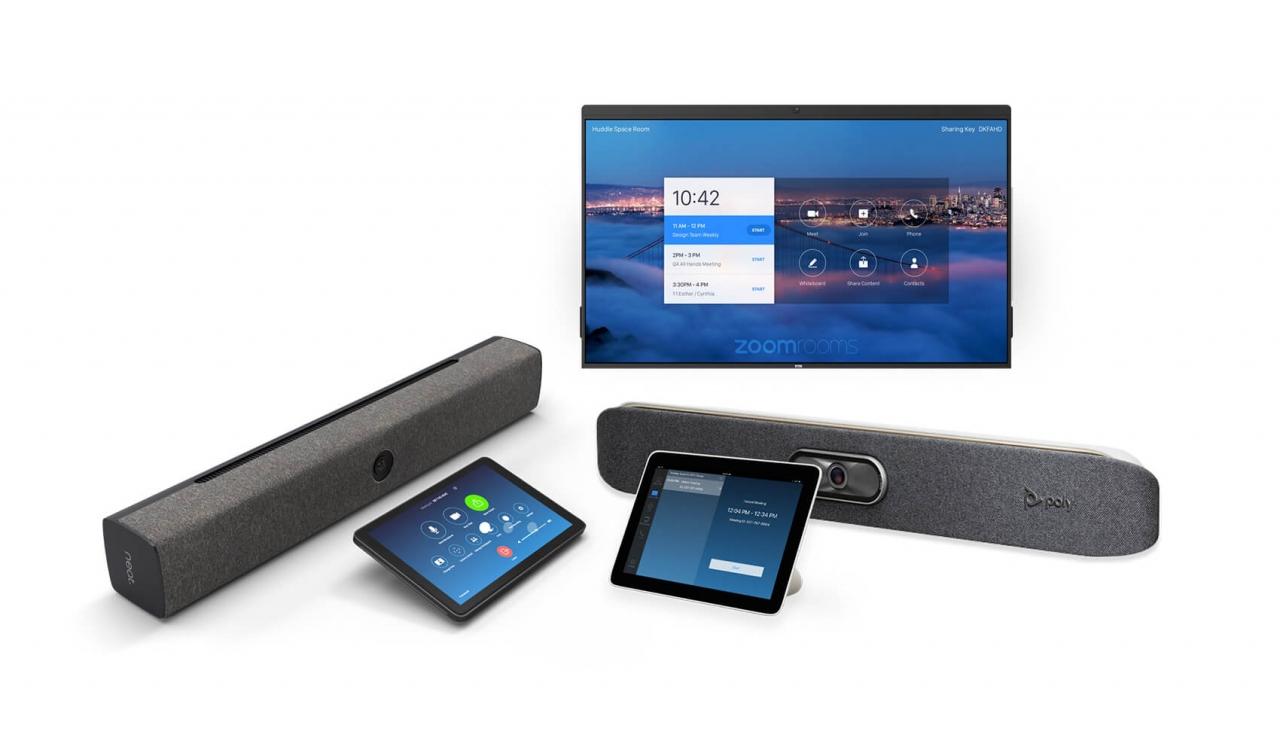- Collaboration
Modernizing The Meeting Room: 3 Big Trends

It should come as a surprise to no one that we collectively spend a substantial amount of time in meetings at work. In the U.S. alone, the Bureau of Labor Statistics estimates that there are between 36 and 56 million work meetings held every day. Which means, on average, most employees attend about 62 meetings a month.
With so much of our days devoted to meeting and collaborating with teammates, business leaders have naturally begun to look for new solutions to improve and simplify the meeting experience.
When well-planned, improvements to meeting systems can mean big returns on investment both in terms of workplace productivity and management costs for IT. For employees and the organization as a whole, enhancing meeting experiences can lead to faster, more efficient problem solving, increased innovation, expanded skill development, and even improved job satisfaction. For IT it can reduce the variability in managed systems and infrastructure, minimize the need for technical support for common interactions with meeting technologies, and also help save money on future upgrades.
Meet the Modern Conference Room
The way we think about conference rooms and spaces has changed. Where once, a “meeting space” simply referred to any location in which one could find a large table surrounded by a reasonable number of chairs, the concept now includes all the infrastructure and technologies that enable employees to meet and collaborate.
And more and more, that “room” may even be completely virtual with workers collaborating through video conferencing tools online.
In just the past few years, modernizing conference rooms has become a top priority for IT teams everywhere. Reimagining the meeting experience for today’s employees has meant designing adaptable meeting and collaboration solutions for workers that increasingly work remotely on their own devices, prefer interactive video-based communications, and expect technology to simply work.
Influenced heavily by the changing ways teams are working together, a number of common trends have emerged with respect to modernizing meeting and collaboration spaces. Independent analyst firm, Gartner, recently reported that organizations everywhere have similar strategies for updating meeting spaces, which include the following:
- Designing more flexible meeting infrastructure to meet varying demands for equipment and spaces
- Reducing the use of custom-built multi-vendor meeting room solutions that are expensive and difficult to manage
- Finding reliable solutions and services that can evolve to meet users’ changing needs over time
What’s more, the technologies that support meetings and collaboration continue to expand their breadth of capabilities that enable organizations to design meeting solutions that deliver richer, more integrated experiences for both in-room and remote employees. As a result, modern meeting spaces often have:
- Intelligent facilities scheduling
- Cloud-based video conferencing
- Wireless connectivity for easy sharing from any device
- Integrated displays that include 360° and PTZ cameras, whiteboards, document cameras, and remote screencasting
- Automated meeting capture
Of course, while every organization will have their own unique requirements for updating meeting spaces and systems, more and more IT leaders have begun looking to similar solutions to help modernize the meeting solutions and tackle productivity hurdles that really add up at scale. The following are 3 major trends emerging in efforts to modernize both meeting spaces and collaboration solutions, and the experiences they can create when they all work in sync.
3 Big Trends in Modernizing Meeting Room Resources
1. Smarter meeting rooms
Everyone has had to do the conference room shuffle at some point. While many meetings are planned ahead of time, they sometimes run over or don’t always last as long as they are scheduled. And still, other meetings happen in the moment where participants jump into whatever space is available. It’s a reality that makes finding and scheduling appropriate meeting spaces somewhat chaotic even with corporate calendaring tools and meeting room scheduling solutions.
The good news is, what were once stand-alone systems are now becoming smarter, integrated conferencing and collaboration systems. Smarter, integrated meeting resources make meeting spaces as flexible and efficient as your people are — automatically showing resources as available if meetings don’t happen or end early — and minimizing the end-user’s need to interact with meeting technologies, automatically starting and recording video conferences as scheduled.
Modern meeting room setups also increasingly enable participants to connect to technologies wirelessly, instead of fumbling with messes of cables and switching inputs on in-room displays. Newer tools can also incorporate the physical aspects of the room into your meeting system, including lighting, window shades, and HVAC. And workplace analytics can help your team improve the planning of resources, in addition to providing new meeting performance analytics that can help your organization get more out of meetings at scale over time.
2. Huddle rooms and agile meeting spaces
The number of private rooms and office spaces is shrinking, while open office plans and concepts like hot-desking are quickly becoming the new normal. These trends have caused business leaders to get creative about how they design, equip, and allocate space for meetings and collaboration.
Fully-equipped conference rooms are still in high demand, but more often than not, teams don’t require all the infrastructure and features of premium meeting spaces. Modern meeting strategies prioritize the features used most frequently to outfit things like huddle rooms and less conventional meeting areas.
One of the newest solutions is streamlined turnkey meeting room kits like Zoom Rooms (pictured below), WebEx Room Kits, or Skype Room Systems. These systems limit complexity and tend to work reliably and predictably, without the need for a lot of user training. They are also easily installed and readily available for relatively quick deployment to new spaces as demand changes.

3. Cloud everything
Deploying a new device shouldn’t require local setup. Instead, IT managers are looking to cloud services that enable the ability to simply plug in a device, have it work, and push any updates out through the cloud to multiple rooms and setups at once. It’s a boon to teams who are already strapped for time and resources for other mission-critical tasks.
What’s more, cloud-based meeting systems provide even greater opportunity for interoperability, which can enable customizations that improve the user experience for your organization’s specific needs.
Meetings Don’t End in the Conference Room
Just as meetings don’t always happen inside a conference room, today, they also don’t have to end in the conference room (or when the video conference ends).
Recordings of meetings can now extend collaboration beyond the meeting, enabling people who couldn’t attend in real-time to watch and engage later, providing a point of reference and context for ongoing work and even for new contributors, and more. By simply pressing record on the video conferencing tools they currently use, employees can easily record their meetings.
And they’re already doing it. In a recent poll of Project Management Institute (PMI) members over 30% reported that they have, in fact, used their video conferencing software to record meetings.
This presents a problem you might not even know you had.
Can you be confident that the meetings your employees are already recording — full of sensitive business information — aren’t getting into the wrong hands, either internally or outside your company?
The problem is that, unlike other kinds of files, you can’t password protect an mp4. Even file sharing systems like Dropbox and Google Drive can still let the right people download and share private meeting recordings with just about anyone. Recordings of internal meetings could even end up shared for the world to see on that site where everyone goes to share videos — YouTube. As of this writing, a quick search on YouTube for “internal meeting” returns a remarkable 883,00 results. Even if we assume that 95% of those are fairly harmless, that would still leave some 44,000 videos that likely weren’t intended for public viewing.
One would hope that nothing confidential from your organization has been shared publicly, but the very real possibility should give every business pause.
The Solution: Automate Meeting Capture Using A Secure Video Management System
A solution for managing meeting recordings helps organizations tackle new security risks that arise when employees have imperfect options for storing and sharing internal videos. A video management system like Panopto works with your video conferencing technology to automatically capture meeting recordings, upload them to a secure online video library, and transcribe everything said in the meeting to also make the contents of your recordings searchable. Just as importantly, it also enables fine-grained permissions management controls for administrators so meeting recordings can only be viewed by the right people.

What’s more, automating meeting capture at scale is a meeting modernization strategy that businesses are increasingly implementing to further support productivity and collaboration.
 According to a recent Wainhouse Research survey, 69% of respondents agreed that it is useful to have recordings of past video meetings available for later access as a reference source. Whether it’s the freedom to fully engage and not take notes or the ability to share a meeting with someone who couldn’t attend, there are many reasons people want to record their meetings. Download our latest white paper to learn 10 reasons to record your meetings.
According to a recent Wainhouse Research survey, 69% of respondents agreed that it is useful to have recordings of past video meetings available for later access as a reference source. Whether it’s the freedom to fully engage and not take notes or the ability to share a meeting with someone who couldn’t attend, there are many reasons people want to record their meetings. Download our latest white paper to learn 10 reasons to record your meetings.
DOWNLOAD: 10 Reasons Your Business Should Record All Your Meetings
But pressing record isn’t enough. Your people need to be able to find, search and share those recordings with ease, not to mention stream and interact with them on any device to get the full benefit of these important knowledge assets.
A secure video platform that includes meeting intelligence solutions can integrate with your existing meeting technologies to help secure your internal video content assets and also help you fully maximize meeting productivity.
Panopto is the leading solution for managing, sharing, and searching meeting recordings. Contact us today to make Panopto part of your intelligent meeting environment.



